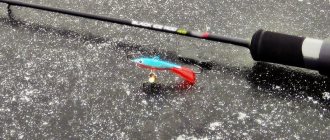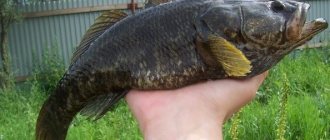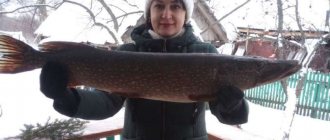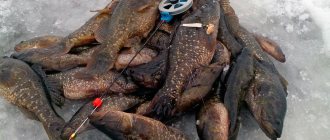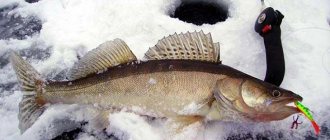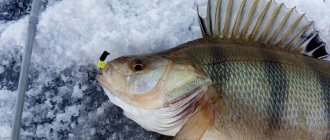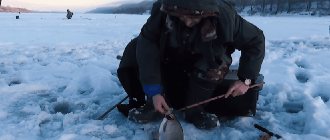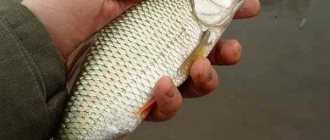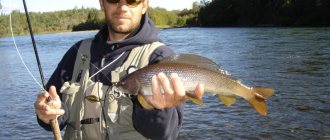First, let's get acquainted with rotan. This is a predator fish whose scales are gray-brown. Rotan inhabits small and swampy lakes, overgrown ponds, and dry river beds. This fish is unpretentious to living conditions, as well as to the lack of oxygen in the water. It is buried in silt when water bodies dry out completely and freeze. Rotan tries to avoid fast currents and does not like fuss. It hides in underwater thickets of plants, from where it conducts observation and hunting. Rotan bites in almost any weather and any time of year.
The best bite occurs not very far from the shore, in quiet thickets of reeds. Although rotan is a predator, it is not fast in its movements, and therefore does not particularly resist when pulled, which may appeal to amateur fishermen and beginners, and catching rotan can be a very interesting activity. Pieces of fresh meat, liver or lung are preferred as bait for rotan; worms are also good. Maybe he can also feast on his fellow creatures. The predator recognizes all these baits unmistakably. To catch rotan, a spoon is most often used. This is the best tackle, which creates strong swaying and swaying, which is what attracts the attention of the predator. Rotan, like all predator fish, reacts to the spinner, but in an unusual way. She irritates him more than attracts him. With all this, the fish will only pay attention if it feels and sees a large piece of tasty bait, which it will feel in its large mouth. This means that you need a larger hook than the standard one soldered into the spinners, and always with a long shank. The shape of the spinner for catching rotan, in principle, is not particularly important, but the color plays a major and important role. The spinner for rotan should be light so that he notices it and is better attracted. A larger soldered hook makes hooking more likely.
Winter shine of rotan
The most effective way to catch rotan is with a spinner on the first ice. During the first ice, rotan greedily eats all living things that it can grab, stocking up on nutrients before the dead winter. The predator can survive even in bodies of water that freeze to the bottom, falling into suspended animation in ice and air bubbles. If the pond does not freeze to the bottom in winter, then you can catch a firebrand even in the dead of winter, although the bait for this is thrown under the nose of a passive predator.

Catching rotan with a spinner in winter with bait - along with a jig, the main way of fishing under the ice for this fish. Coarse tackle with a large bait and hook (relative to a jig) is simply easier to handle when the bighead is biting madly. Removing a firebrand from a large hook of a long spoon is faster and easier than trying to pull a small jig out of a deep throat. The main point of such lure in winter is the bait on the hook. Any spinner will do, as long as it is the right size.

But for those who like pure baitless lures, you can turn around, but only during the first ice and closer to spring, when the predator is active. Ardent fans of baitless fishing in the dead of winter apply attractants to spoons or simply lubricate the bait, for example, with the meat of already caught firebrands. But in winter it’s better to put at least a small piece of rotan meat, a tail or a scrap of chicken skin on the hook - then a bite is guaranteed.
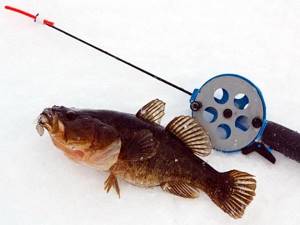
Winter fishing gear
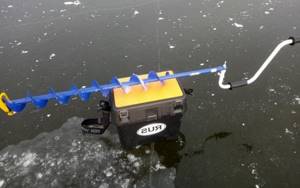
To catch firebrands, both active and passive fishing methods are used. You can use fishing rods of various designs for winter fishing, made at home or purchased. The main requirement for a fishing rod is an elastic whip. Rotan bites sharply and after hooking it strongly resists. The equipment must be reliable.
A suitable line diameter would be 0.14 or thicker. A smaller diameter may break when playing fish at shallow depths. In addition, a thick fishing line does not really alarm rotan. A reel with extra line will make you feel more comfortable.
Electrical tape is used to balance the gear. To successfully hunt for rotan on the first ice, use the method of active fishing with a balance beam. True, with this method you will have to run from one hole to another. You can’t do this type of fishing without balanced gear.
You should choose a fairly hard nod, preferably a spring type. This is due to the size of jigs, bait, as well as the frequency of play.
Rotan jigs are used in considerable sizes, so for correct play you need nods with the appropriate load-carrying capacity. The fishing rod should be light and elastic; such tackle significantly improves the animation of the bait.
Recommended reading: How to catch pike perch with a jig
Working spinners
As a spinner for rotan in winter, an ordinary small perch piece, up to 5 cm long with one hook, is more often used. There is no need to buy special baits for the firebrand - any bait of a suitable size lying around in the box will do. This could be a micro spinner, a jig head, a walleye cone or a small jig.
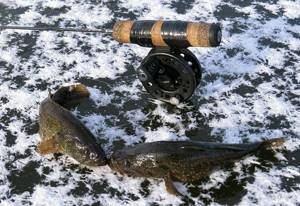
A horizontal spinner-boat or a homemade one is also suitable. The main thing in a spinner for rotan in winter is the weight of the tackle, and not the bait itself, in order to twitch the bait on the hook. And it’s easier to get such bait out of the mouths of firebrands than a small hook. This predator pecks greedily; the largemouth calmly swallows prey commensurate with its own size.
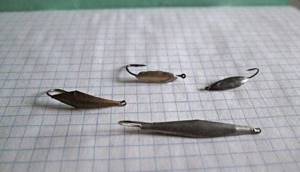
Groundbait and bait
Even such a hungry and active fish as rotan quickly approaches the fed place. The easiest way to provoke a predator to actively bite is with protein bait.
A standard mixture based on breadcrumbs is also capable of luring a predator. To enhance the effect, you should add live food to it:
- bloodworm,
- mormysha,
- worm or maggot.
Rotan reacts well only to animal baits and loves the smell of raw meat. Beef is often used for fishing. It is cut into small pieces, then lowered into the hole.
The meat should attract trophy fish. It is not uncommon for several large individuals to be caught at once in a place baited in this way. There is always room for experimentation; instead of beef, you can take the meat or offal of another animal.
Chicken skin is a well-known catching bait for rotan. It allows for a game that is attractive to predators and holds the hook well.
Experienced fishermen recommend using lard as bait in winter; it can attract large specimens. A small piece is enough and it will serve you for a very long time. This bait rarely flies off the hook, and attracts fish even after 20 casts.
Bites continue even after the bait has been in the mouths of several predators.
Recommended reading: Common ruff
A piece of fish meat has a similar effect on fish. Rotan is a predator, his nature will not allow him to miss a tasty morsel. Some people catch the first two or three fish, and then cut them up to use as bait. True, fish meat does not stay on the hook for long. It is necessary to constantly monitor and adjust so that the piece of meat does not slip off the hook.
Rigging a fishing rod with a spinner on a firebrand in winter
No special equipment is required for rotan. There is no point in using ultra-thin tackle - this fish is not very careful and is not at all afraid of thick fishing lines. A fishing rod of any design, a fishing line of about 2-0.3 mm and, in fact, a spinner will do. In some places you can find rotan weighing up to a kilogram. Therefore, when hunting for such a predator, the equipment is used more powerfully.
It is necessary to use winter fluorocarbon as a fishing line - it is stronger and more resistant to external damage than summer monofilament. Rotan has small and sharp teeth. The predator, of course, will not bite the fishing line in one go. However, during active fishing, the line is damaged a little with each deep throat. Fluorocarbon is more reliable in this regard.
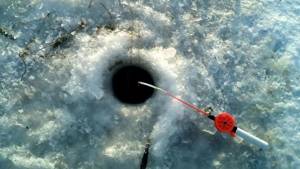
Rotan behavior in winter

In general, fishing for rotan in winter brings very good results. However, the best catches occur early in the season, in November and December. This is due to changes in the habits of fish under the ice. As soon as the reservoir is covered with ice, the fish does not leave its summer habitat. She prefers to stay near the shore among thickets of grass, where the depth rarely exceeds one meter.
With the onset of deep winter, vegetation gradually dies, producing methane and devouring oxygen. Rotan is forced to roll deeper. It is better to look for it at a depth of 1.5 meters and deeper. It can be both in sharp holes and among areas with a flat bottom.
Deaf winter affects rotan, although to a lesser extent than most fish. He becomes more cautious and passive. The predator’s favorite places are overgrown areas of the reservoir, which are better saturated with oxygen at first. When oxygen starvation occurs in a reservoir in winter, the activity of the predator noticeably decreases.
Tactics and fishing techniques
Let's look at how to catch rotan in winter using a spoon correctly. First, choose the right place. Typically, the firebrand stands at a shallow depth, up to 1.5 meters, in thickets of algae and mud. This is an overgrown coastal zone, driftwood, mud islands, and shallow bays. Read more about winter fishing for rotan.
It is advisable to drill several holes, and then check the points one by one, stopping where the bite is best. When hunting for large rotan in winter, you need to specifically check places that are promising for predator ambushes. A branch that has fallen into the water, an old tire, a snag, a hole with algae - any relief anomaly serves as a refuge for a predator.
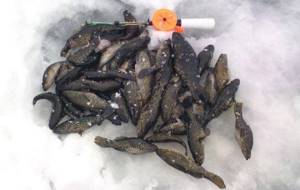
By the way, if it is known for certain that a trophy rotan lives in this reservoir, and at the same time there are a lot of small ones, then the absence of small bites near a promising shelter clearly indicates the presence of large ones. It’s just that the big guy has already gobbled up the small change that was there before, and is waiting in ambush for his next victim. Such places are worked out more carefully, and large, tasty bait is offered.
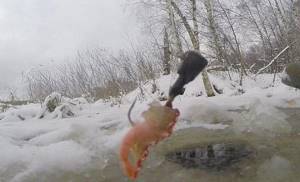
Sometimes groundbait works well in winter. A few pieces of meat from previously caught fish need to be thrown into the hole - there is no better bait for rotan. If the bite was observed in some place earlier, then first of all you need to fish there. Largemouth loves certain areas of water bodies, although it can wander throughout the entire water area during periods of activity. The bites of this fish are greedy, and you need to hook it right away - otherwise you will have to dig out the hook from the depths of the mouth for a long time.
Fishing Features
The best bait for spinners for rotan in winter is the meat of the firebrand itself, half or tail, as well as chicken skin or lard. He does not refuse any by-products of meat, fish, worms and all other animal baits. Read more about rotan baits. Remember, if you want to catch a larger firebrand, then the bait must be large.
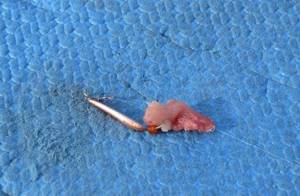
The fishing technique is simple - twitching, swaying, shaking the bait with a spoon at the bottom. If the bottom is covered entirely with mud or algae, a working descent is installed so that the bait is above this carpet. You can simply leave a fishing rod with bait without moving. The firebrand will find the bait by smell and attack. Sharp jerks, rocking and slow pulling - if you have an attachment, the rotan will take it. When fishing without bait, you should pay more attention to the game and choose the one that provokes the fish to bite. But this type of fishing is more for fun. If the goal is to catch more fish with cutlets, you need to use bait.
Subscribe to the channel:
My YouTube channel RYBAFAN on fishing:
We're OK
Catching rotan in summer using a spoon
In the summer, when the water in reservoirs heats up to significant temperatures, the summer rotan fishing season opens. Finding this fish will not be difficult, as it is found in many reservoirs. But rotan, one might say, prefers peace and tranquility, as well as the absence of other inhabitants, especially predatory ones, such as pike, for example. Large individuals can be looked for among thickets of plants, but this is not the rule. In the summer, rotan loves worms as bait, but does not shy away from other meat delicacies. It is worth noting that the freshness of delicacies is very important and essential for rotan, so it is better to change the bait more often. It is unlikely that rotan will bite immediately on the first cast. First he will watch from ambush. But after several casts, the fish will forget about its wait-and-see tactics and begin to attack your bait. The grip of the rotan is strong, this fast and sharp jerk will make you feel it to the fullest. Therefore, an appropriate reaction is needed, that is, a swift and merciless cutting.
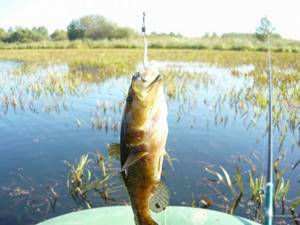
In summer, rotan is quite active and greedily bites. It happened that you could catch a bucket of fish with a single bait. In this position, the main thing is to have time to complete all the manipulations: pull out the hooks, attach the worm and cast again. Of course, it happens when the fish don’t bite for quite a long time. Then it is recommended to simply change the fishing location. There is another secret - to install a hard type nod, which is needed to create a certain level of sensitivity and is very effective.
As you can see, catching rotan in summer is exciting and interesting, and can become a favorite habit on summer evenings.
Dimensions of homemade tube baits
Do-it-yourself winter lures for pike perch are made in smaller sizes compared to summer lures. This is caused by the different intensity of predator activity in the warm and cold seasons. If you fish in open water with baits in sizes 60–100 mm and a diameter of 10–12 mm, then options for under-ice lures are used in sizes from 40 to 60 mm and a thickness of no more than 8 mm. When assembling a fishing tool from composite links, you can vary the size by joining different diameters and turning the sections in opposite directions of the bait relative to its central axis. All these nuances, as well as the cutting angles, allow the product to be given its own unique play pattern, thereby giving the spinner individuality and originality.

Important! Both summer and winter pike perch spoons can be made in a noise version with your own hands. To do this, it is necessary to add a couple of bearing balls into the sealed cavity of the tubular blank, which freely fit into the hole of the bait along the diameter. During animation, the sound of balls hitting each other and the walls of the pipe will additionally attract the predator to the fishing point.
First timid attempts
In the early 80s, there was no such thing as “ultralight” yet. But then I was already making spinners and catching small perches with them with the sinker placed forward.
And then somehow I came across a rotan, and in a water area where, in principle, there are not many of these fish. I took this as a signal. The logic was simple: if a rotan has teeth, it means it is a predator. And if it’s a predator, it should be caught using spinning artificial baits, right?
But the problem was that at that time our set of spinning baits was extremely scarce. In fact, almost 99% of it came down to any hardware. So I offered rotan my smallest “turntables”. The result was close to zero. I caught a total of three. And with a worm in the same time it would be possible to catch fifty.
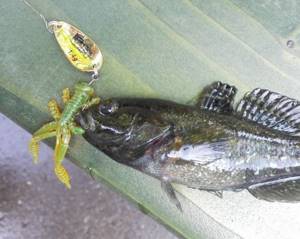
Since rotan is caught in the closest zone, its reaction to the bait can often be seen directly. Several times I noticed a rotan standing in the water column - and carried out the lure in close proximity to it. The maximum that happened was the fish’s body turning towards the bait. And no attempts to attack her. I then concluded for myself that rotan is extremely inert. And in terms of its feeding style, it is closer to a scavenger than to a hunter of nimble live prey. And for some time I covered the rotan topic for myself.
